Sabine FBX SOLO SM-820 Manual
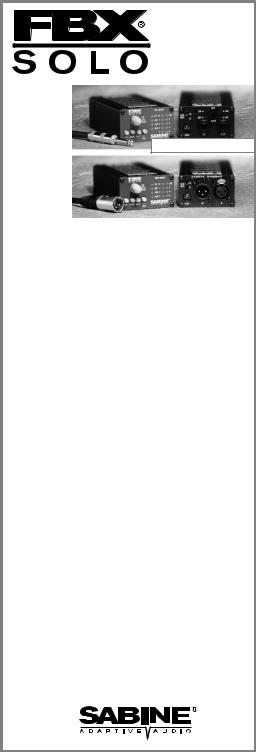
OPERATING
GUIDE
FBX-SOLO Model SL820
|
|
FBX-SOLO Model SM820 |
|
|
TABLE OF CONTENTS |
||
• |
Front Panel Description |
5 |
|
• |
Back Panel Descriptions |
6 - 7 |
|
• |
Applications for Use |
8 - 9 |
|
• |
Before you Begin... |
10 - 13 |
|
• |
Operating Instructions |
13 |
|
• |
FBX Setup Instructions |
14 - 18 |
|
• |
Trouble Shooting Tips |
18 - 19 |
|
• |
Product Specifications |
20 - 21 |
|
• |
Warranty & Cautions |
22 - 23 |
|
QUICK START OPERATION
For best results, read all operating instructions before using the FBX-SOLO (pages 12-19).
1.Patch in the SOLO where appropriate for your model, and select the input/ output level on the back.
2.With gain down on the input channel, put the SOLO in Active mode (green bypass LED), then slowly raise the channel gain to the point of feedback.
3.Raise the gain slowly until 7 FBX filters are set, then reduce gain slightly.
4.Adjust the Clip Level on the SOLO, and you're ready to go.
© 2003 Sabine, Inc.

CONGRATULATIONS!
You now have the state-of-the-art in feedback control. The Sabine FBX-SOLO gives you automatic real-time feedback control for any channel of your mix. In setup and during the performance, it gives you more gain and increases the clarity of your mains and monitors. It's the affordable solution to feedback problems, perfect for wireless mics, monitors, acoustic/electric instruments, harmonica mics, multi-mic locations like conference rooms and courthouses — wherever there's an open microphone. The FBX-SOLO incorporates the latest in design and digital signal processing technology. It automatically senses feedback in a sound system and determines its pitch. It then places one of its eight constant "Q" micro-filters on the resonating frequency and eliminates the feedback in typically less than one second.
Special features of the SL820 and SM820:
•New ultra fast Turbo Setup Mode grabs feedback at very low levels.
•The SL820 has 1/4" in/out connectors and input/output level switches for any combination of ins and outs. The SL is for use with acoustic/electric guitars and guitar amplifiers, mixer insert points, powered mixer patch points and high impedance mics.
•The SM820, with selectable phantom power, has XLR in/out connectors for use with balanced microphones.
•Both models offer standard FBX features like switchable filter widths and lockable fixed filters.
•New improved performance - 20 bit A/D conversion, expanded dynamic range & up to 8 FBX filters.
HOW CAN THE SOLO BE USED?
Assign a SOLO to any specific mixer channel. You can also use the SM820 to connect a phantompowered mic to a non-phantom-powered mixer.
See SOLO Applications on page 8 & 9.
2

THE BEST FEEDBACK CONTROLLER
Before the invention of the FBX, the most common device for controlling feedback was the 31-band graphic EQ. However, the FBX has three distinct advantages. The most obvious is the FBX functions automatically, even during the program. Another is the FBX micro-filters are precisely placed while EQ filters are fixed; FBX filters can be placed between predetermined graphic filters. The difference: FBX filters do not have to be as deep, so there is more system gain. The final and most important advantage is that FBX micro-filters are ten times narrower than 31-band EQ filters. FBX micro-filters return up to 90 percent of the power removed by EQ filters. Over the years, engineers stopped using 12-band EQs in favor of the narrower-filter 31-band EQ for controlling feedback. The FBX represents the next step. An EQ would need more than 10,000 sliders to be equivalent to your FBX. With the SOLO, your monitors will finally sound loud enough, everyone in the audience will understand each word, and the mains will sound natural and transparent.
WHO NEEDS THE FBX?
Virtually every sound system will be improved with the FBX. Small bands that do not have sound technicians can now increase their monitor volumes so they can hear themselves clearly and with full fidelity, without worrying if the program is going to be ruined by feedback.
Auditoriums and churches of all sizes will enjoy reliable feedback control. Hotels and conference centers around the world can offer meeting rooms with sound systems that won’t howl during programs. The SOLO can be installed in theaters, schools, sports arenas, courtrooms — anywhere multiple microphones are used. It can also be used for teleconferencing, intercoms or interactive remote classrooms.
WHY THE FBX?
The simple beauty of the FBX is its ability to quickly and effectively eliminate feedback with narrower filters than ever before possible. The FBX delivers superior sound quality automatically.
3
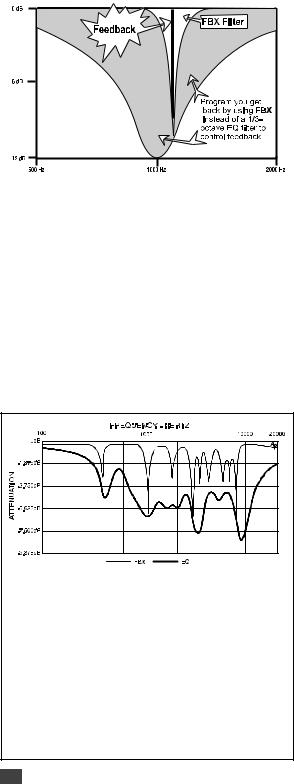
A DIRECT HIT ON FEEDBACK! The FBX-SOLO targets feedback without taking a big chunk out of your sound. Tests prove that a single 1/3-octave EQ slider pulled down 12 dB removes almost half the power going to the speakers over a two-octave range. And, as the illustration above shows, you can't place a graphic EQ filter precisely on the ringing frequency. When you pull down multiple sliders in a normal setup (below), you end up with giant holes in your sound. On the other hand, FBX constant "Q" micro-filters are 10 times narrower - you get back up to 90% of the power you lose with a graphic EQ! That means more gain before feedback and no loss in sound quality.
FREQUENCY RESPONSE TEST: Full Set-Up FBX vs. 1/3-Octave Graphic Equalizer. Test procedure: A PA system was set up using a microphone, mixer, FBX, power amp and two speakers. The system's gain was raised until the FBX removed six feedback points. Next, the FBX was replaced with a 1/3-octave graphic EQ. The EQ was adjusted while the input was raised to the same level achieved with the FBX. The frequency response curves of each device were then plotted.
What this means to you: Doubling the cost of your microphones, speakers and power amp probably would not improve your system's frequency response as much as replacing your EQ with an FBX for chasing feedback.
4
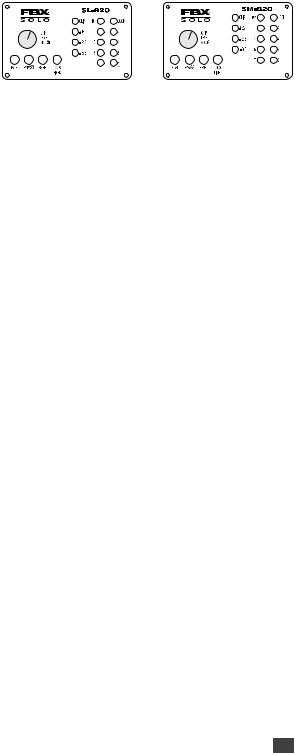
SL820 & SM820 FRONT PANELS
POWER
The On/Off power switch is a two-position push button switch. The LEDs corresponding to all active filters will blink on power-up.
ACTIVE/BYPASS
In Active mode, the unit controls feedback automatically. The two-color "BY" LED lights green when the unit is in Active mode and lights red when in Bypass mode. The mic preamp remains active in Bypass mode; only the FBX function is bypassed.
DUAL-FUNCTION RESET
To reset only the dynamic filters, press and hold the reset button. The LEDs will flash 3 times and then the LEDs that indicate current Dynamic filter placement will shut off (fixed filter LEDs will remain on). To reset ALL filters, hold the reset button until all LEDs go off (approximately 7 flashes).
LOCK FIXED FILTERS
When the "Lock Fixed" button is pressed, its LED will light to indicate that the FBX is in Lock Fixed mode. Lock Fixed mode can be activated at any time after system setup and will stay on until the button is pressed again and the LED turns off. The dynamic filters are not affected (see p.10 for details).
CLIP LEVEL ADJUST
The front panel clip level adjust knob has two functions, and its use will depend on the setting of the output switch on the back panel. When the output is set to Unity: the Clip Level Adjust allows you to set the optimal clip level for the input signal, in order to optimize the dynamic range while maintaining unity gain. Higher input levels will require the Clip Level Adjust to be turned more counterclockwise to avoid distortion; lower input levels will require the knob to be turned clockwise, to minimize noise.
5
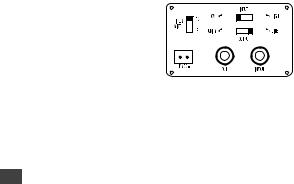
Recommended setting of the Clip Level Adjust: the clip LED should blink intermittently. Regardless of the Clip Level Adjust, setting Unity on the back panel will maintain unity gain (no net gain or loss of signal level).
When the back panel output is set to Line, the SOLO acts as a preamplifier, and the Clip Level Adjust knob becomes a gain control (see SL820 & SM820 Input Low/High Switch sections below).
SIGNAL LEVEL/TURBO INDICATOR
The LED ladder indicates the signal strength relative to the SOLO's input level. Clip LED flashes independently to indicate when the SOLO is in Turbo Setup mode.
FILTER ACTIVITY
When one of the unit’s constant "Q" filters is activated, the corresponding LED lights. A blinking LED indicates the filter that was most recently activated. All filter LEDs cycle to indicate Turbo Mode is about to disengage.
FILTER WIDTH SWITCH
Switch to narrow 1/10-octave filters for music applications or to wider 1/5-octave filters for spoken word applications. The change takes effect only on power up. Selecting a new width has no effect unless you power down and then power up again.
12 VOLT DC ADAPTOR
The FBX external power supply (single unit power supply; model # SPSPOWR) is included with the unit. Use of any other power supplies may cause permanent damage to the unit and WILL VOID THE WARRANTY.
SL820 BACK PANEL ONLY
INPUT LOW/HIGH SWITCH
Switch to Low for instrument or (high impedance microphone) IN. Use with low level inputs such as
piezo mic pick ups — this provides a 30 dB boost in the FBX's input gain structure. Switch to High for insert or line IN: use with high level output instruments and signal processors.
6

OUTPUT UNITY/LINE SWITCH
Switch to Unity (for level in = level out) for use with amplifiers that accept low level signals, such as guitar amps. In the Unity setting, the SL820 input level equals the output level. Switch to Line (for line level out) if your signal needs pre-amplification. In the Line setting the gain is adjusted between 0 and +35 dB (High IN); +30 to +65 dB (LOW IN) via the clip level adjust.
INPUTS & OUTPUTS
The connector labeled IN/OUT serves as both the unit's input (tip) and output (ring) when used with a single TRS plug. When used with a Y-cord, use the IN/OUT as the input and the OUTPUT as the output (for channel insert configurations).
SM820 ONLY BACK PANEL
OUTPUT LO/HI SWITCH
In the LO setting, the SM820 has unity gain (input = output); use LO for
mic level. In the HI setting, gain is adjustable between -15 dB and +20 dB using
the clip level adjust; use HI for line level, or when you need to preamp the signal.
PHANTOM POWER ON/OFF SWITCH
The SM820 is set to "Phantom Power - OFF" at the factory. If you wish to use phantom power, move the switch to "ON." NOTE: The SM820 will not pass phantom power from your mixer.
INPUT
The input accepts balanced XLR-3 (PIN 2 high) plugs.
OUTPUT
Use balanced XLR-3 plugs (PIN 2 high) for balanced mixer line inputs. NOTE: the output impedance of the SM820 is unbalanced.
7
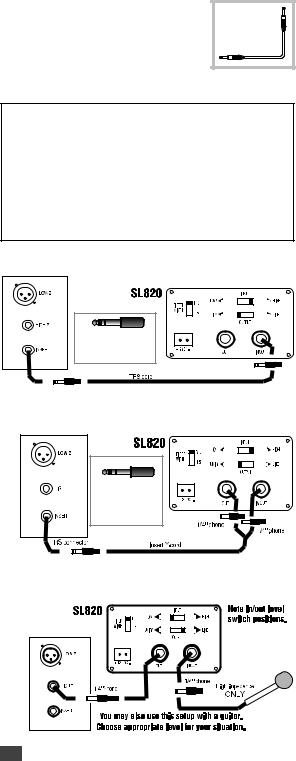
APPLICATIONS
SL820: You can use the SL820 with acoustic/electric guitars and guitar amplifiers, mixer insert points, pow- SL820
ered mixer patch points and high impedance mics. Use the following
wiring diagrams as guides for setup:
NOTE: For Configurations 1-4, the output control on the back panel of the SL820 may actually be set to either
Unity or Line. In the Unity setting the output level will equal the input level, and, since the input level to the
SL820 in such a setup is already line level, the output will be line level as well. When the output setting is switched to Line, the front panel knob becomes a gain control, and it is possible to add additional gain to your signal path, if needed. Care should be taken in this situation to avoid overdriving your mixer channel.
1. Mixer Channel Insert with TRS/TRS Cable
NOTE: Use a TRS connector at both ends of cable.
2. Mixer Channel Insert w/ Insert "Y" Cable
NOTE: Use a TRS connector only at the mixer insert point.
3. Mixer Channel HI Impedance Mic on Line Input
8
